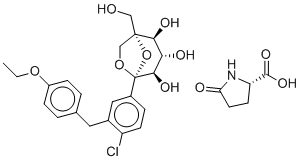This product is for research use only, not for human use. We do not sell to patients.

| Size | Price | Stock |
|---|---|---|
| 250mg | $320 | Check With Us |
| 500mg | $520 | Check With Us |
| 1g | $780 | Check With Us |
Cat #: V3907 CAS #: 1210344-83-4 Purity ≥ 98%
Description: Ertugliflozin pidolate (formerly known as also known as PF-04971729; trade name: Steglatro), the pidolate salt of ertugliflozin, is a potent, orally bioavailable and selective inhibitor of the sodium-dependent glucose cotransporter 2 (SGLT2)approved in 2017 by FDA for treating type 2 diabetes mellitus.
Publications Citing InvivoChem Products
Product Promise

- Physicochemical and Storage Information
- Protocol
- Related Biological Data
- Stock Solution Preparation
- Quality Control Documentation
| Molecular Weight (MW) | 566.0 |
|---|---|
| Molecular Formula | C27H32ClNO10 |
| CAS No. | 1210344-83-4 |
| Storage | -20℃ for 3 years in powder formr |
| -80℃ for 2 years in solvent | |
| Solubility In Vitro | DMSO: ≥ 50 mg/mLr |
| Water: N/Ar | |
| Ethanol: N/A | |
| SMILES Code | CCOc1ccc(Cc2c(Cl)ccc([C@]34OC[C@](O3)([C@H]([C@@H]([C@H]4O)O)O)CO)c2)cc1.OC([C@@H] 5CCC(N5)=O)=O |
| Synonyms | PF-04971729 pidolate; PF 04971729; PF04971729; PF-04971729-00; Ertugliflozin pidolate; Ertugliflozin L-pyroglutamic acid |
| Protocol | In Vitro | Ertugliflozin L-pyroglutamic acid (PF-04971729 L-pyroglutamic acid) demonstrates >2000-fold selectivity for SGLT2 inhibition (relative to SGLT1) in vitro |
|---|---|---|
| In Vivo | Ertugliflozin L-pyroglutamic acid (PF-04971729 L-pyroglutamic acid) reveals a concentration-dependent glucosuria after oral administration to rats |
| Solvent volume to be added | Mass (the weight of a compound) | |||
|---|---|---|---|---|
| Mother liquor concentration | 1mg | 5mg | 10mg | 20mg |
| 1mM | 1.7668 mL | 8.8339 mL | 17.6678 mL | 35.3357 mL |
| 5mM | 0.3534 mL | 1.7668 mL | 3.5336 mL | 7.0671 mL |
| 10mM | 0.1767 mL | 0.8834 mL | 1.7668 mL | 3.5336 mL |
| 20mM | 0.0883 mL | 0.4417 mL | 0.8834 mL | 1.7668 mL |
This equation is commonly abbreviated as: C1 V1 = C2 V2
- (1) Please be sure that the solution is clear before the addition of next solvent. Dissolution methods like vortex, ultrasound or warming and heat may be used to aid dissolving.
- (2) Be sure to add the solvent(s) in order.




































